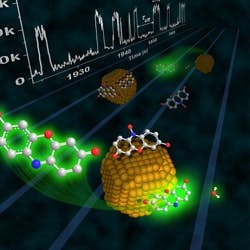Nanocatalyst Analysis Gives Glowing Results
More on NanoCatalysts
Nanoparticle catalysts can offer significant advantages. They provide far larger surface area than conventional catalysts. In addition, some materials not ordinarily catalytic become so at the nanoscale. The materials are attracting attention for fuel cells and other applications. Now, a microscopic method developed by researchers at Cornell University (http://www.cornell.edu), Ithaca, N.Y., is providing a better understanding of how a nanoparticle catalyst performs.The researchers rely on a molecule that glows under ultraviolet light when bound to a gold nanocatalyst. They contact immobilized spherical gold nanoparticles with a dye solution. The dye molecule briefly binds to a nanoparticle, causing removal of an oxygen atom. The new molecule then fluoresces (Figure 1). The blip of light remains until the molecule releases from the catalyst. The researchers took pictures every 30 milliseconds and were able to isolate the blips produced at individual nanoparticles and identify single catalytic events.They found that some nanoparticles carry out reactions differently than others. On some, the dye molecule binds to the surface, is changed and then releases. On others, the changed molecule moves to another position before releasing. Some nanoparticles produce both effects. 
